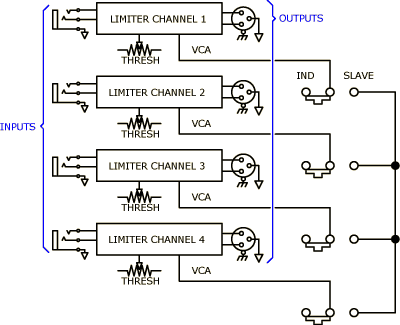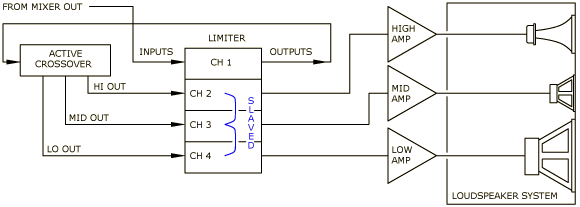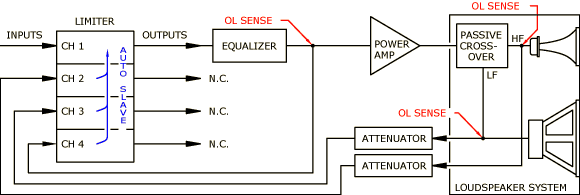Knowledge Base
Limiters Unlimited
Limiters Unlimited
(or: 'Buffer the Amp Fire Saver')
Monty Ross, Rane Corporation
RaneNote 127 written 1991; last revised 8/97
- Auto-Slave
- Protecting Loudspeakers
- Protecting Systems
- Signal Overload Protection
- Limiting Volume
Introduction
Limiters are in the protection business, limiting audio systems to safe levels. These limits protect loudspeakers, protect the audio signal from clipping, protect the neighbors, and protect ears.
A limiter continuously monitors the audio signal, looking for levels exceeding its adjustable threshold. A limiter normally operates at unity gain and has no effect on the signal. If excessive levels are detected, the Voltage Controlled Attenuator (VCA) automatically reduces the gain. If the level never exceeds the threshold, the signal remains unaffected.
Auto-Slave, Extending Your Limits
In the applications and examples that follow, you will read about multi-channel limiters with auto-slave. Auto-slaving provides the ability to tie together the circuitry that controls the VCA's of two or more limiters. Each limiter channel maintains its independent threshold adjustment. The amount of gain reduction is shared with all slaved channels when any one has exceeded its threshold. Figure 1 shows a simplified block diagram of a quad limiter with this feature.

Figure 1. Quad Limiter with Auto-Slave
Protecting Loudspeakers with Limiters
Loudspeakers manufacturers provide recommended power ratings for their drivers. These ratings are not absolute, and should be used only as a guide. Sound contractors diverse experiences using loudspeakers sometimes lead them to formulate their own power ratings. Limiters allow for real world applications. With a limiter you can customize your speaker protection scheme for maximum reliability.
It is important to note that midrange and tweeter (high-frequency) drivers cannot handle as much power as woofers (low-frequency drivers). Therefore it is especially important that tweeters and midranges are protected by different limiter thresholds than the woofer.
Multi-amped systems often use limiters for speaker protection. Limiters are typically placed at the input of each power amplifier for each driver. In Figure 2 we show a tri-amped system protected by a limiter. Set each limiter's threshold to match the power handling of each driver. Whenever the high, mid or low limiters reach their set limit threshold, all three bands limit by the same amount. This is due to the three slaved channels in the limiter, assuring the system's spectral balance stays constant. (If only one band limited and the other two increased in volume, the result would be an abrupt change in the tonal balance of the system.) This clever trick provides the least audible and most effective form of multi-amped system power limiting.

Figure 2. Active Tri-Amped System with Protection
Taking Your System to the Limit
A properly designed system has the ability to operate as loudly as needed for the application. When limiters are introduced into a system their thresholds are set to protect the systems' components.
Sometimes limiting occurs before a satisfactory volume level is reached. For example, a touring band could perform in a venue that is much bigger than its equipment can handle. Higher power speakers or more powerful amplifiers may be called for. This permits higher limit levels to be set, thus allowing a louder system.
All Systems Under Control
Signal overload problems may occur when cascading multiple audio signal processors. Take for example a parametric equalizer with a single band boosted by 10 dB to flatten a room. If a loud note in this same frequency range is present, the overload light on the equalizer illuminates. By then it is too late, the signal is clipped. Additionally, overloading could be overlooked if the overload indicators are obscured by security covers or a closed rack. This problem is corrected by adding a 4-channel limiter with all four channels slaved together as shown in Figure 3. The first channel is the primary input limiter and up to 3 points are simultaneously monitored by the limiter's other 3 channels. The threat of overload automatically activates the limiter rather than lighting an LED, thus preventing overload altogether. Simply add a wye (Y) connector in the audio path anywhere you need protection and connect it to one of the 3 other inputs. When any single processor nears an unwanted level, the first channel limits the gain at the input of the whole system, preventing overload.

Figure 3. Signal Overload Protection
Reign Over Your Volume
A benefit of limiters is their automatic gain control ability. No one needs to be present to watch and change the levels of a system once you properly set the thresholds. A limiter prevents the need to gain ride a system. In this sense, the limiter acts as a compressor. Increase the volume so that the quiet parts are loud enough to be heard and the limiter automatically prevents the loud passages from clipping the amplifiers or overpowering the speakers.
Professional audio systems are often operated by untrained people. Take a music/paging system in a restaurant for instance. The owner of a restaurant wants specific levels of music in certain dining rooms so his customers or neighboring businesses will not be annoyed. Placing a limiter in the audio chain will prevent everyday users from turning the volume up too loud. The limiter's circuit tends the shop.
Another application involves hearing. We sometimes take our hearing for granted. Hearing is non-linear and constantly changing. When the sounds our ears pick up get loud (sensitivity to loudness varies with different people), some automatic systems come into play. Some of these changes are aural (involuntary muscular responses in the ear) and some are neural (the way the brain responds to impulses from the ear). The mechanism between the ear and brain begins to shut down in an attempt to protect itself. This action manifests itself by dulling your hearing senses. The natural response to this is to boost the volume or EQ controls to compensate for the perceived drop in level. Extended exposure to high sound levels can result in permanent hearing damage. Limiters help control these levels. When using a limiter for this purpose we recommend security covers to make the settings tamper proof.
Summary
Put limiters in the signal path -- anywhere there is a place where signals can't be monitored by someone or where there might be too much signal. At the output of the signal source, at the input of an equalizer, at the input of a mixer, at the input of a power amplifier or at the input to an active crossover. You can be very creative with limiters to achieve your particular goal. Especially if your limiter has an auto-slave option.
References
- M. Ross, "An Investigation into How Amplifier Clipping is Said to Burn-Out Loudspeakers, and How Limiters Can Save Them," presented at the 89th Convention of the Audio Engineering Society, J. Audio Eng. Soc. (Abstracts), vol. 38, p.870 (Nov 1990), Preprint 2956.
![]() "Limiters Unlimited" This note in PDF.
"Limiters Unlimited" This note in PDF.